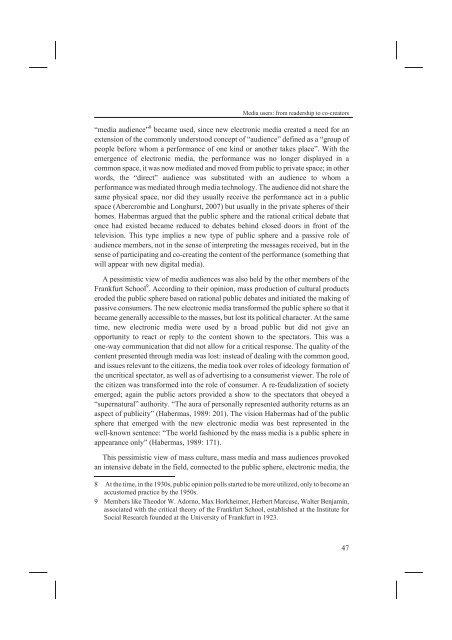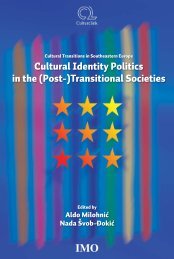D:\Documents and Settings\Ana\My Documents\Biserka-knjiga ...
D:\Documents and Settings\Ana\My Documents\Biserka-knjiga ...
D:\Documents and Settings\Ana\My Documents\Biserka-knjiga ...
You also want an ePaper? Increase the reach of your titles
YUMPU automatically turns print PDFs into web optimized ePapers that Google loves.
Media users: from readership to co-creators<br />
“media audience” 8 became used, since new electronic media created a need for an<br />
extension of the commonly understood concept of “audience” defined as a “group of<br />
people before whom a performance of one kind or another takes place”. With the<br />
emergence of electronic media, the performance was no longer displayed in a<br />
common space, it was now mediated <strong>and</strong> moved from public to private space; in other<br />
words, the “direct” audience was substituted with an audience to whom a<br />
performance was mediated through media technology. The audience did not share the<br />
same physical space, nor did they usually receive the performance act in a public<br />
space (Abercrombie <strong>and</strong> Longhurst, 2007) but usually in the private spheres of their<br />
homes. Habermas argued that the public sphere <strong>and</strong> the rational critical debate that<br />
once had existed became reduced to debates behind closed doors in front of the<br />
television. This type implies a new type of public sphere <strong>and</strong> a passive role of<br />
audience members, not in the sense of interpreting the messages received, but in the<br />
sense of participating <strong>and</strong> co-creating the content of the performance (something that<br />
will appear with new digital media).<br />
A pessimistic view of media audiences was also held by the other members of the<br />
Frankfurt School 9 . According to their opinion, mass production of cultural products<br />
eroded the public sphere based on rational public debates <strong>and</strong> initiated the making of<br />
passive consumers. The new electronic media transformed the public sphere so that it<br />
became generally accessible to the masses, but lost its political character. At the same<br />
time, new electronic media were used by a broad public but did not give an<br />
opportunity to react or reply to the content shown to the spectators. This was a<br />
one-way communication that did not allow for a critical response. The quality of the<br />
content presented through media was lost: instead of dealing with the common good,<br />
<strong>and</strong> issues relevant to the citizens, the media took over roles of ideology formation of<br />
the uncritical spectator, as well as of advertising to a consumerist viewer. The role of<br />
the citizen was transformed into the role of consumer. A re-feudalization of society<br />
emerged; again the public actors provided a show to the spectators that obeyed a<br />
“supernatural” authority. “The aura of personally represented authority returns as an<br />
aspect of publicity” (Habermas, 1989: 201). The vision Habermas had of the public<br />
sphere that emerged with the new electronic media was best represented in the<br />
well-known sentence: “The world fashioned by the mass media is a public sphere in<br />
appearance only” (Habermas, 1989: 171).<br />
This pessimistic view of mass culture, mass media <strong>and</strong> mass audiences provoked<br />
an intensive debate in the field, connected to the public sphere, electronic media, the<br />
8 At the time, in the 1930s, public opinion polls started to be more utilized, only to become an<br />
accustomed practice by the 1950s.<br />
9 Members like Theodor W. Adorno, Max Horkheimer, Herbert Marcuse, Walter Benjamin,<br />
associated with the critical theory of the Frankfurt School, established at the Institute for<br />
Social Research founded at the University of Frankfurt in 1923.<br />
47



